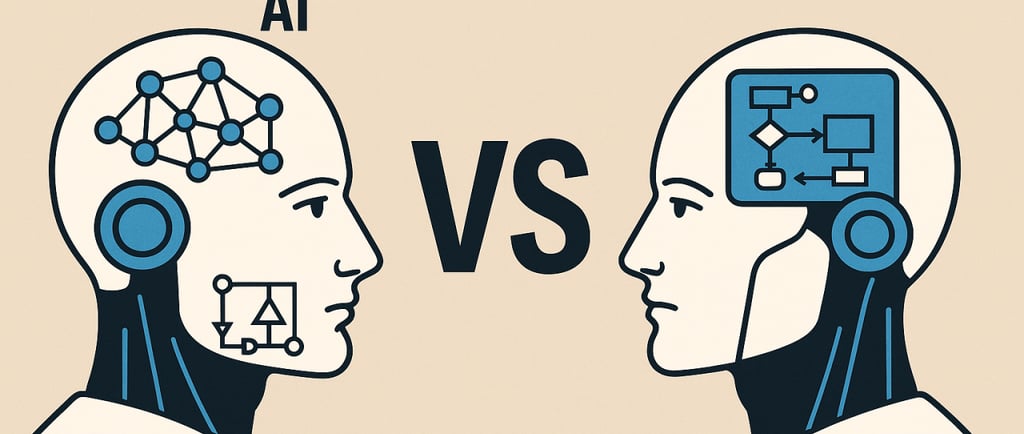Neurosymbolic AI vs Agentic AI: Unlocking the Next Level of Intelligence in Manufacturing and Energy
What’s the next frontier in AI for manufacturing and energy? It’s not just about more automation or bigger models. It’s about smarter, safer, and more accountable AI. In my latest article, I break down: The key differences between Neurosymbolic AI (AI that reasons, explains, and follows rules) And Agentic AI (AI that plans, decides, and takes autonomous action) Why read it? ✅ Learn how these technologies can help factories, grids, and plants go beyond pilots to real operational transformation ✅ See why combining logic + autonomy could be the key to trusted, large-scale AI deployment ✅ Get inspired by practical use cases — from predictive maintenance to grid resilience
Matthew Alberts Ph.D.
6/24/20253 min read


As manufacturers and energy companies work to modernize operations, improve resilience, and hit ambitious sustainability targets, AI has become central to their digital strategies. But not all AI is created equal, and not all will deliver the explainability, autonomy, or safety that these critical industries demand.
Two emerging paradigms deserve closer attention: neurosymbolic AI and agentic AI. Both represent powerful new directions in AI’s evolution, but with different strengths, and together, they may hold the key to building truly intelligent, trustworthy systems for the industrial world.
Neurosymbolic AI ->AI That Thinks Before It Acts
Neurosymbolic AI blends two worlds:
Neural networks for perception, recognizing patterns in complex data like images, sensor streams, or audio.
Symbolic logic for reasoning, applying rules, knowledge graphs, or ontologies to structure decisions, follow cause-effect chains, and comply with constraints.
In manufacturing & energy, this can enable:
Causal diagnostics, not just black-box predictions Example: When a turbine sensor detects abnormal vibration, a neurosymbolic model could reason through machine diagrams and maintenance history to identify the likely failing component, and explain its logic step-by-step.
Zero-defect manufacturing Combine computer vision for defect detection with formal rules that define acceptable tolerances or align with regulatory specs, reducing errors and avoiding recalls.
Energy grid decision support Models that fuse sensor data with logic-based load-balancing rules to reason about cascading impacts during high-demand events, making recommendations that follow regulatory and safety guidelines.
Safer human-robot collaboration Robotic systems that can reason symbolically about workspace rules, human proximity, and task sequencing to avoid unsafe interactions.
Agentic AI -> AI That Acts Toward Goals
Agentic AI takes AI beyond individual predictions or isolated tasks:
It creates goal-seeking systems that plan, decide, and take action across multiple steps, often interacting with tools, APIs, or physical devices.
Think of AI not just as an advisor, but as a collaborator that gets things done.
In manufacturing & energy, this could power:
Autonomous production scheduling AI agents that manage production plans, shift schedules, and inventory levels, dynamically reoptimizing after equipment failure or supply chain disruption without waiting for human intervention.
Grid resilience agents Autonomous agents that monitor grid conditions, detect anomalies, and trigger protective or restorative actions across distributed assets, in real-time, at scale.
AI-driven document automation From safety reports to emissions tracking, agents could gather data across ERP, sensor networks, and third-party feeds to create regulatory filings, audit trails, or performance summaries.
Continuous improvement loops Agents could autonomously propose and test small process optimizations, learning over time to improve yield, energy efficiency, or throughput.
The Power of Convergence: Agentic + Neurosymbolic AI
What if our agents didn’t just act, but could also reason logically about safety, compliance, and consequences before taking action? That’s the promise of combining agentic and neurosymbolic AI:
Agentic AI provides autonomy and action.
Neurosymbolic AI provides reasoning, guardrails, and explainability.
Imagine:
A factory AI agent that autonomously schedules production, but only within safety margins and labor rules encoded in a symbolic logic layer.
A grid management agent that can reason about legal, environmental, and technical constraints as it balances load or dispatches assets during storms.
This kind of fusion could help:
Build trust in AI-driven decisions in high-stakes environments.
Reduce regulatory and operational risk.
Enable more resilient, adaptive, and human-aligned industrial systems.
Call to Action for Industrial Leaders
Start small but think big. Pilot these AI paradigms on contained use cases (e.g., predictive maintenance, document automation, grid micro-optimization).
Collaborate across the ecosystem. No one company can build this alone. Work with technology partners, startups, and research labs innovating in these areas.
Invest in AI governance. As these AI systems gain autonomy, robust frameworks for oversight, auditability, and human-in-the-loop control become critical.
The next wave of AI won’t just help us see the future. It will help us shape it, if we build it thoughtfully.
Let’s continue the conversation. Are you exploring neurosymbolic or agentic AI? Where do you see the greatest opportunities, or risks, in manufacturing and energy?
